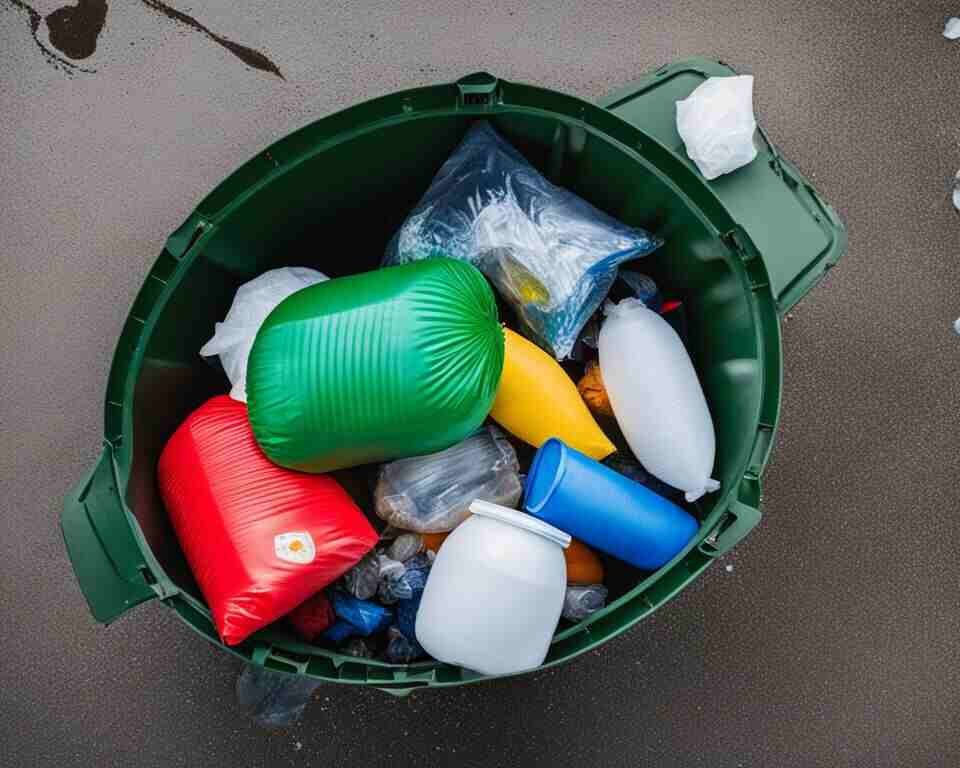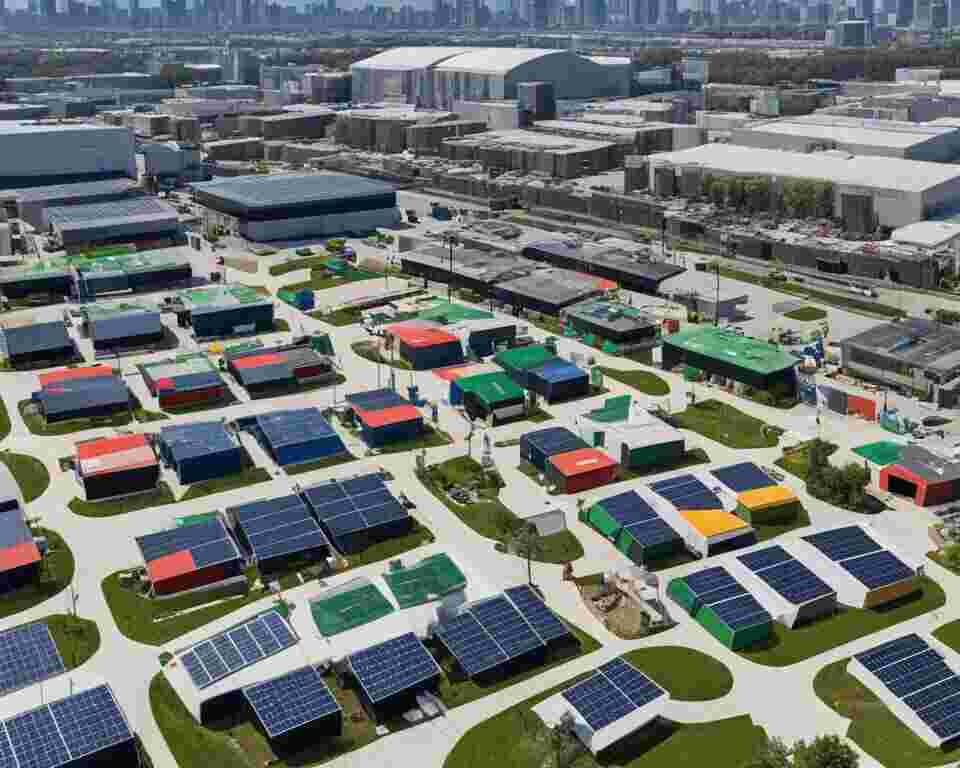As the popularity of inflatables continues to soar, it’s essential to address the environmental impact and explore sustainable solutions. In this article, I will look into the recyclability of inflatables and provide eco-friendly tips for their disposal. Let’s discover how we can minimize waste and protect our planet while still enjoying these fun-filled products.
Key Takeaways
- Most inflatables are not conventionally recyclable due to factors like material composition and lack of recycling infrastructure.
- Improper disposal of inflatables can contribute to landfill waste and pollution in waterways.
- To promote sustainable inflatable disposal, consider repairing leaks and extending the lifespan of these products.
- Explore responsible disposal options, such as recycling or repurposing, to minimize the environmental impact.
- When purchasing inflatables, choose eco-conscious options made from recyclable materials.

The Environmental Challenge of Inflatable Products
Inflatable products, such as toys, pools, and advertising inflatables, have become increasingly popular due to their affordability, versatility, and fun factor. However, these inflatables pose significant environmental challenges that cannot be overlooked.
One of the main concerns is the composition of these products, particularly the use of Polyvinyl Chloride (PVC), a type of plastic that is commonly used in inflatables. PVC is known to contain hazardous chemicals, such as phthalates and lead, which can pose a risk to human health and the environment. These chemicals can leach out of inflatables and contaminate the surrounding soil and waterways, causing long-term harm to ecosystems.
Moreover, the vast majority of inflatables are not conventionally recyclable due to the complex combination of materials used in their construction. Most inflatables are made of a combination of PVC, fabric, and other synthetic materials, which makes them difficult to separate and recycle efficiently. As a result, these non-recyclable inflatables end up in landfills, further contributing to the growing waste problem.
The Impact of Inflatables on Landfills and Waterways
The disposal of non-recyclable inflatables has a significant impact on landfills and waterways. As these inflatables are discarded and sent to landfills, they take up valuable space and contribute to the mounting waste problem. The decomposition of inflatables also releases harmful chemicals into the environment, further polluting the soil and potentially contaminating groundwater.
In addition to landfills, inflatables also have a significant impact on waterways. When improperly discarded or abandoned, they can easily be carried by wind or water, ending up in rivers, lakes, and oceans. These abandoned inflatables can cause harm to aquatic life, entangling marine animals or being mistaken for food. The accumulation of plastic waste, including inflatables, in water bodies contributes to the global issue of marine pollution.
The Composition and Hazards of PVC in Inflatables
PVC, or Polyvinyl Chloride, is a type of plastic commonly used in the production of inflatables. While PVC may have its functional benefits, such as flexibility and durability, it also comes with significant environmental and health hazards.
The production and disposal of PVC-based inflatables contribute to the release of hazardous chemicals into the environment. PVC contains additives like phthalates and lead, which aid in the manufacturing process but can have detrimental effects on ecosystems. When inflatables made with PVC are discarded and end up in landfills or waterways, these hazardous chemicals can leach out and enter the surrounding environment, posing a risk to wildlife and ecosystems.
Furthermore, the disposal of PVC inflatables through incineration can release toxic dioxins and furans into the air, contributing to air pollution and potential health risks for nearby communities.
Why Most Inflatables Are Not Conventionally Recyclable
Despite efforts to promote recycling and sustainable practices, the majority of inflatables are not conventionally recyclable. The complex composition of inflatables, including the combination of PVC, fabric, and other synthetic materials, makes the recycling process challenging and economically unviable.
Traditional recycling facilities are not equipped to handle the separation and processing of the different materials present in inflatables. The mixed materials require specialized recycling techniques that are currently not widely available.
As a result, most inflatables, once they reach the end of their lifespan, are ultimately destined for landfill disposal, perpetuating the cycle of waste accumulation and environmental harm caused by these products.
Can Inflatables Be Recycled?
In this section, we will address the question of whether inflatables can be recycled. Recyclable inflatables present a promising solution towards reducing waste and promoting sustainable practices. Let’s explore the different recycling options available for these products and discuss the challenges that arise when attempting to recycle inflatables.
Recycling options for inflatables vary depending on the type of material used in their construction. Some recyclable inflatables are made from PVC-free and phthalate-free materials, which can be recycled through specialized recycling centers. These materials are typically labeled with recycling symbols to indicate their recyclability.
However, it’s important to note that not all inflatables are conventionally recyclable. Many inflatable products, such as large water slides and bounce houses, are made from PVC, a non-recyclable material that poses challenges for traditional recycling processes.

Recycling inflatables made from PVC often requires innovative approaches and specialized recycling facilities. Some companies and organizations have started initiatives to recycle PVC inflatables, transforming them into new products such as bags, wallets, and other durable goods. These recycling programs aim to divert inflatables from landfills and promote a circular economy.
While recycling options for inflatables made from PVC are relatively limited, there are alternative ways to minimize waste and promote sustainability. Repurposing and upcycling these inflatables can breathe new life into them, extending their usefulness and reducing overall waste.
In summary, while not all inflatables can be conventionally recycled, there are recycling options for specific materials and innovative approaches available for more challenging materials like PVC. Additionally, repurposing and upcycling inflatables can provide sustainable alternatives to disposal. The next sections will discuss further sustainable disposal methods and eco-friendly tips for inflatable usage and disposal.
Sustainable Disposal of Inflatables
In this section, I will focus on sustainable disposal methods for inflatables, providing you with tips on repairing leaks and extending the lifespan of these products to minimize waste. Additionally, I will explore responsible disposal options for inflated products.
Repairing Leaks and Extending Lifespan
One of the key aspects of sustainable inflatable disposal is repairing leaks and extending the lifespan of these products. By fixing leaks, you can keep inflatables functional for a longer time, reducing the need for constant replacements and ultimately minimizing waste. Here are some tips to help you repair leaks:
- Identify the location of the leak by inflating the product and feeling for escaping air or using soapy water to identify the bubbles.
- Clean the affected area using warm, soapy water and a soft cloth or sponge.
- Apply a patch kit specifically designed for the material of your inflatable, following the manufacturer’s instructions.
- Allow the patch to dry completely before reinflating the product.
By regularly inspecting and repairing leaks, you can extend the lifespan of your inflatables, reducing the environmental impact associated with constant disposal and replacement.
Responsible Disposal Options for Inflated Products
While repairing leaks can help prolong the lifespan of inflatables, there may come a time when they reach the end of their usability. In such cases, it’s important to choose responsible disposal options to minimize the environmental impact. Here are some recommended disposal methods:
- Recycling: Some inflatables, such as water slides or bounce houses made from recyclable materials, can be recycled. Check with your local recycling center to see if they accept inflatable materials for recycling.
- Donation: If your inflatables are still in good condition, consider donating them to local community centers, schools, or charities that may be able to put them to use.
- Upcycling: Get creative and repurpose your inflatables for other purposes. For example, you can turn an old pool float into a unique cushion cover or use deflated balloons for arts and crafts projects.
- Responsible Disposal: If recycling or donation is not an option, dispose of inflatables responsibly by following your local waste management guidelines. This ensures that they are properly handled and do not end up in landfills or waterways.
By choosing sustainable disposal options, we can contribute to a cleaner environment and reduce the negative impact of inflatable waste on our planet.
Recycling and Repurposing Inflatable Pools
When it comes to inflatable pools, there are sustainable options for both recycling and repurposing these large inflatables. By implementing these practices, we can minimize waste and promote responsible inflatable waste management.

Recycling inflatable pools is a viable solution to reduce their environmental impact. However, due to the specific materials used in their manufacturing, recycling can be challenging. PVC, which is commonly found in inflatables, can be difficult to recycle due to its durability and composition. Nevertheless, with the right processes and facilities, it is possible to recycle inflatable pool materials and minimize their contribution to landfill waste.
Repurposing is another excellent option for inflatable pool disposal. By repurposing old or damaged inflatable pools, we can give them a new life and prevent them from ending up in landfills. Some creative ideas for repurposing inflatable pools include using them as raised garden beds, creating water catchment basins, or transforming them into outdoor seating areas.
| Recycling Inflatable Pools | Repurposing Inflatable Pools |
|---|---|
| Reduces landfill waste | Provides a new purpose for old inflatables |
| Requires specialized recycling facilities | Encourages creative and sustainable use of materials |
| Challenges with PVC recycling | Minimizes environmental impact |
By recycling and repurposing inflatable pools, we can make significant strides in inflatable waste management. These practices contribute to a more sustainable future, reducing the strain on landfills and preserving valuable resources.
Understanding Inflatable Toys Recycling Process
In this section, we will dive into the recycling process for inflatable toys and explore the challenges associated with their recycling. Recycling inflatable toys is crucial for reducing waste and minimizing their impact on the environment.
Challenges with Recycling Inflatable Pool Toys
Recycling inflatable pool toys poses several challenges due to their composition and design. Most inflatable pool toys are made from polyvinyl chloride (PVC), which is a difficult material to recycle. PVC contains harmful chemicals and additives that make it non-recyclable through conventional methods.
Additionally, the complex structure of inflatable pool toys, including air chambers and valves, makes the recycling process more challenging. These features require proper disassembly and separation of different materials, which can be time-consuming and labor-intensive.
Furthermore, inflatable pool toys are often contaminated with dirt, sand, and other debris after being used in outdoor settings. This contamination further complicates the recycling process and may render the materials unfit for recycling.
Alternatives to Recycling: Repurposing and Upcycling
While recycling may not be the most viable option for inflatable pool toys, there are alternative ways to give them a new life and reduce waste. Repurposing and upcycling offer creative solutions for reusing these toys in various ways.
One alternative is to repurpose inflatable pool toys into new functional items. For example, you can transform a deflated pool float into a comfy cushion, a hammock, or a pet bed. These repurposed creations not only save the toys from ending up in landfills but also add a unique flair to your home or outdoor space.
Another option is upcycling, which involves transforming inflatable pool toys into entirely different products. With some creativity and DIY skills, you can turn old pool toys into trendy bags, accessories, or even quirky planters for your garden.
By choosing repurposing and upcycling as alternatives to recycling, you can extend the lifespan of inflatable pool toys and reduce their environmental impact.
Guidelines for Recycling Inflatable Materials
In order to promote sustainable waste management and reduce the environmental impact of inflatables, it is important to understand how to properly recycle these materials. Here are some guidelines to help you navigate the recycling process:
Identifying Recyclable Inflatable Materials and Products
When it comes to recycling inflatables, it is crucial to identify which materials and products can be recycled. While not all inflatables are conventionally recyclable, certain materials can be repurposed and reused. Examples of recyclable materials commonly found in inflatables include:
- PVC (polyvinyl chloride)
- Nylon fabric
- Vinyl (polyvinyl chloride) film
By recognizing the recyclable components of inflatables, you can ensure that these materials are properly diverted from landfills and recycled in an eco-friendly manner.
How to Approach Recycling Centers for Inflatable Disposal
When disposing of inflatables, it is important to approach recycling centers that are equipped to handle these specific materials. Here’s how you can effectively approach recycling centers for inflatable disposal:
- Research local recycling centers: Start by researching recycling centers in your area that accept materials like PVC, nylon, and vinyl. Look for facilities that specialize in recycling or repurposing inflatables.
- Contact recycling centers: Reach out to the recycling centers you identified and inquire about their specific requirements and processes for recycling inflatables. They may have guidelines regarding deflation, cleaning, and preparation of the materials.
- Follow disposal instructions: Once you have identified a suitable recycling center, follow their instructions for dropping off or shipping the inflatables. Make sure to properly prepare the materials according to their guidelines to ensure successful recycling.

When disposing of inflatables, it is important to approach recycling centers that are equipped to handle these specific materials. Here’s how you can effectively approach recycling centers for inflatable disposal:
| Step | Action |
|---|---|
| 1 | Research local recycling centers |
| 2 | Contact recycling centers |
| 3 | Follow disposal instructions |
By following these guidelines and approaching recycling centers specialized in handling inflatable materials, you can ensure that your inflatables are properly disposed of in an environmentally-friendly manner.
Eco-Friendly Tips for Inflatable Usage and Disposal
In this section, I will provide you with eco-friendly tips for both the usage and disposal of inflatables. By following these tips, you can not only extend the lifespan of your inflatables but also minimize the environmental impact associated with their disposal.
Proper Maintenance to Avoid Premature Disposal
- Regularly inspect your inflatables for any signs of damage, such as leaks or tears. Promptly repair any damages to prevent further deterioration.
- Keep your inflatables clean by regularly washing them with mild soap and water. This will help prevent the buildup of dirt, debris, and mold, which can accelerate wear and tear.
- Store your inflatables in a cool, dry place when not in use. Direct exposure to sunlight and extreme temperatures can weaken the materials and shorten their lifespan.
By following these maintenance tips, you can significantly extend the life of your inflatables and reduce the frequency of disposal.
Eco-Conscious Choices in Inflatable Products
When purchasing inflatable products, it’s important to make eco-conscious choices to minimize the environmental impact. Here’s what you can do:
- Opt for inflatables made from eco-friendly and sustainable materials, such as PVC-free or recycled materials. Look for certifications like the Green Seal or Forest Stewardship Council (FSC) to ensure the product meets environmental standards.
- Consider the durability of the inflatable before making a purchase. Choosing a high-quality, durable product will minimize the need for frequent replacements and reduce waste.
- Support brands that prioritize eco-friendly practices, such as using renewable energy sources, implementing recycling programs, or offering take-back options for end-of-life inflatables.
By making eco-conscious choices when purchasing inflatable products, you can contribute to a more sustainable and environmentally-friendly future.
Remember, proper maintenance and eco-conscious choices are key to maximizing the lifespan of your inflatables and reducing their environmental impact. By following these tips, you can enjoy your inflatables guilt-free while minimizing waste and promoting sustainability.
Conclusion
In conclusion, the question of whether inflatables can be recycled has a complex answer. While some inflatables, such as those made from PVC, pose challenges for conventional recycling methods, there are still eco-friendly disposal options available.
It is crucial to prioritize sustainable waste management practices when it comes to inflatables. Repairing leaks and extending the lifespan of these products can significantly reduce waste and minimize their impact on the environment. Additionally, considering eco-conscious choices when purchasing inflatables, such as opting for materials that are more easily recyclable, can make a difference in the long run.
While recycling inflatables may not always be straightforward, repurposing and upcycling are alternative options that can contribute to reducing waste. By finding creative ways to give new life to inflatable products, we can mitigate their negative impact on landfills and waterways.
In summary, it is important to approach inflatable disposal with an eco-friendly mindset. While the recycling of all inflatables may not be feasible, adopting responsible disposal practices and seeking out sustainable alternatives can help promote a cleaner, greener future. By taking individual actions, we can collectively make a significant difference in reducing the environmental footprint of inflatables and contributing to a more sustainable world.

